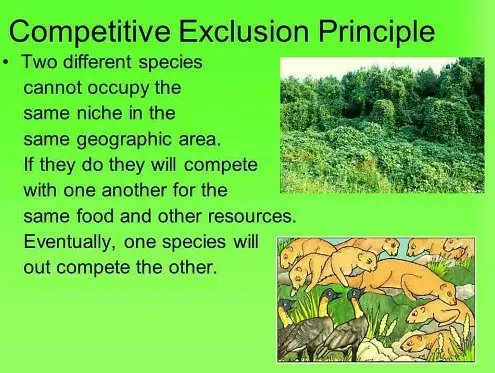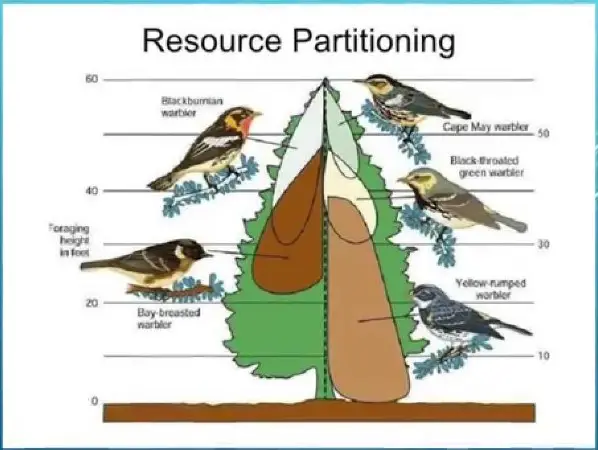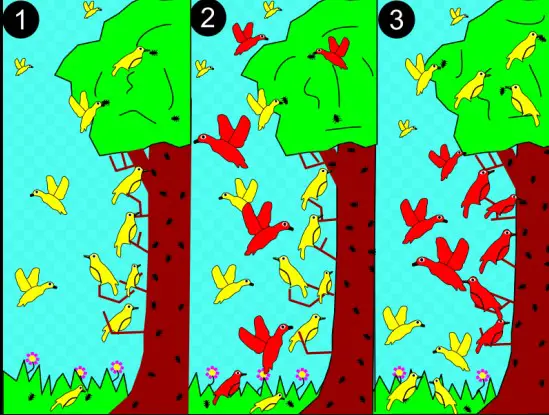In the complex web of life, species interact in various ways to survive and thrive. Among these interactions, competition for resources plays a critical role in shaping ecosystems. This competition leads to two fundamental ecological principles: competitive exclusion and resource partitioning. Both mechanisms drive the diversity and distribution of species within habitats, yet they operate through distinctly different processes.
Competitive exclusion asserts that two species competing for the same limited resources cannot coexist at constant population values; eventually, one will outcompete and exclude the other from the habitat. On the other hand, resource partitioning refers to the division of resources by species to help avoid competition, allowing for the coexistence of diverse species within the same environment. These concepts are pivotal in understanding how species adapt to ecological pressures and maintain biodiversity.
Competitive exclusion and resource partitioning illustrate nature’s intricate balance, highlighting the adaptability and resilience of species facing competition. Through these processes, ecosystems achieve a dynamic equilibrium, where species either find unique niches or face exclusion. This equilibrium is essential for sustaining biodiversity, influencing the structure and functionality of ecosystems worldwide.

Ecological Competition
Definition and Significance
Ecological competition occurs when two or more species in an ecosystem vie for the same resources that are in limited supply. This struggle can significantly affect the population, distribution, and biodiversity of species within the environment. Understanding competition is essential for comprehending how ecosystems function and maintain balance.
Types of Competition
Intraspecific Competition
This type occurs among individuals of the same species. They compete for the same resources, such as food, water, and territory. Intraspecific competition can regulate population size, promoting survival of the fittest.
Interspecific Competition
Occurs between different species competing for similar resources. This type can be more complex, as it involves species with potentially different strengths and weaknesses.
Competitive Exclusion
Concept Overview
The principle of competitive exclusion states that two species that compete for the exact same resources cannot stably coexist. One species will eventually outcompete and exclude the other from the environment.
Gause’s Principle
Named after the scientist G.F. Gause, who formulated it, Gause’s Principle provides a theoretical foundation for competitive exclusion, demonstrating it through controlled experiments with microorganisms.
Real-world Examples
- The displacement of native red squirrels by invasive grey squirrels in Britain is a classic example of competitive exclusion driven by direct competition for food and habitat.
Impacts on Biodiversity
Competitive exclusion can lead to a decrease in biodiversity within an ecosystem as dominant species monopolize resources, forcing others into extinction or migration.
Resource Partitioning
Definition and Explanation
Resource partitioning refers to the process by which species adapt to compete less directly by using resources differently. This differentiation allows for coexistence rather than exclusion.
Types of Resource Partitioning
Spatial Partitioning
Species utilize different habitats or areas within the same environment, reducing direct competition.
Temporal Partitioning
Species may use the same space but at different times. For example, one species might be active during the day and another at night.
Morphological Partitioning
Adaptations in physical characteristics allow species to utilize resources differently. For example, birds with different beak shapes may feed on the same tree but on different parts of it.
Benefits to Species Diversity
Resource partitioning enhances biodiversity by allowing a greater number of species to coexist by minimizing direct competition for resources.
Differences Highlighted
Basis of Differentiation
The fundamental difference between competitive exclusion and resource partitioning lies in their outcomes: one leads to the dominance of one species over another, while the latter promotes coexistence.
Impact on Ecosystems
While competitive exclusion can limit the diversity of species in an ecosystem, resource partitioning can increase it by allowing more species to fill different niches.
Long-term Outcomes for Species
Competitive exclusion often results in the loss of a species from an ecosystem, whereas resource partitioning can lead to speciation and increased biodiversity as species evolve to exploit different resources or niches.

Case Studies
Competitive Exclusion in Action
One of the most cited examples of competitive exclusion is the displacement of native red squirrels by grey squirrels in the United Kingdom. Introduced in the 19th century, grey squirrels competed more effectively for food resources and habitat, leading to a drastic decline in red squirrel populations. This case vividly illustrates how a more resource-efficient species can outcompete and displace another, altering the composition of local ecosystems.
Resource Partitioning Success Stories
In the tropical rainforests of South America, the diversity of nectar-feeding bat species showcases successful resource partitioning. Despite occupying the same geographical area, these bats feed on different plant species, at varying heights, and at distinct times of the night. This specialization minimizes competition and supports a rich biodiversity, highlighting the adaptive strategies species can develop to coexist.
Ecological Balance
Role of Competitive Exclusion and Partitioning
Both competitive exclusion and resource partitioning play crucial roles in maintaining ecological balance. While competitive exclusion ensures that species must efficiently use resources to survive, resource partitioning allows for a diversity of species to thrive in different niches. Together, these mechanisms contribute to the dynamic equilibrium of ecosystems, where species populations are regulated naturally, preventing any one species from overwhelming the system.
Importance for Ecosystem Health
A healthy ecosystem is marked by its biodiversity and the complex interactions between its organisms. Competitive exclusion and resource partitioning are vital in fostering this biodiversity, ensuring that ecosystems are resilient, productive, and capable of providing essential services such as air and water purification, pollination of crops, and carbon sequestration.
Human Influence
Anthropogenic Effects on Natural Processes
Human activities have profound effects on the natural processes that govern competitive exclusion and resource partitioning. Habitat destruction, pollution, and the introduction of invasive species disrupt the balance, often leading to biodiversity loss. For example, the spread of invasive species can override natural competitive relationships, leading to the decline or extinction of native species.
Conservation Efforts and Strategies
In response to the challenges posed by human influence, conservationists have developed various strategies to protect ecosystems:
- Habitat Restoration: Rebuilding natural habitats to support native species and restore ecological balance.
- Invasive Species Management: Controlling or eradicating invasive species to prevent the displacement of native species.
- Protected Areas: Establishing reserves and parks to conserve critical habitats and biodiversity.
- Sustainable Practices: Promoting agricultural, forestry, and fishing practices that minimize impact on ecosystems.
These efforts aim to mitigate human impact, preserve biodiversity, and maintain the health of ecosystems. Through a combination of science-based management, policy-making, and community engagement, we can support the mechanisms of competitive exclusion and resource partitioning in a way that sustains biodiversity and ecosystem services for future generations.
FAQs
What is competitive exclusion?
Competitive exclusion is an ecological principle stating that two species competing for identical resources cannot coexist indefinitely. Over time, the species that utilizes the resources more efficiently will dominate, leading to the exclusion of the less efficient one. This concept underscores the importance of niche differentiation in maintaining species diversity.
How does resource partitioning promote biodiversity?
Resource partitioning allows multiple species to coexist in the same area by utilizing different resources, times, or spaces, reducing direct competition. This adaptation leads to a more stable ecosystem with a higher level of biodiversity. Species evolve to exploit different niches, promoting a diverse community structure.
Can competitive exclusion and resource partitioning occur simultaneously?
Yes, competitive exclusion and resource partitioning can occur simultaneously within ecosystems. While competitive exclusion can eliminate closely competing species, resource partitioning enables the coexistence of various species by minimizing direct competition for resources. Together, they shape the composition and diversity of communities.
How do humans impact competitive exclusion and resource partitioning?
Human activities, such as habitat destruction, pollution, and introduction of invasive species, can disrupt the natural processes of competitive exclusion and resource partitioning. These disruptions can lead to loss of biodiversity and ecosystem imbalances, highlighting the need for conservation efforts to preserve natural habitats and species diversity.
Conclusion
The interplay between competitive exclusion and resource partitioning underscores the complexity and resilience of ecosystems. Through these mechanisms, species evolve and adapt, ensuring ecosystem stability and biodiversity. The delicate balance maintained by these processes is vital for the health of our planet, serving as a reminder of the intricate connections that sustain life on Earth.
Understanding the dynamics of competitive exclusion and resource partitioning is crucial for conservation efforts. It informs strategies to protect endangered species and restore habitats, ensuring the long-term viability of ecosystems. As we continue to explore these ecological principles, we gain deeper insights into the workings of the natural world, guiding our efforts to preserve it for future generations.

